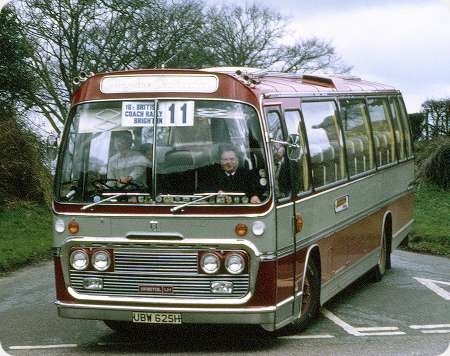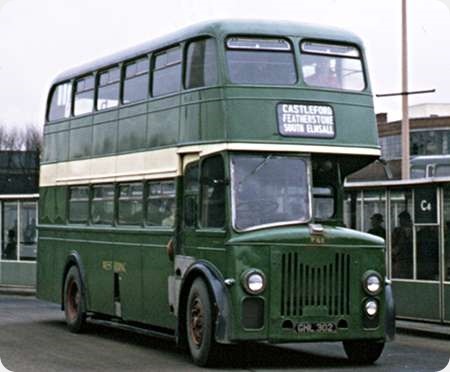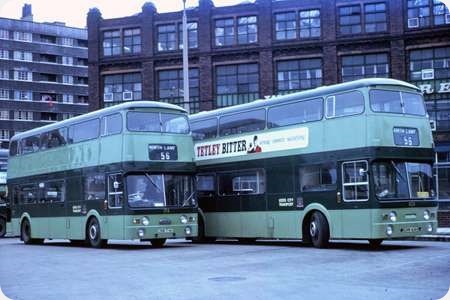Grayline Bicester – Bristol LHL6L – UBW 625H
Grayline Bicester
1969
Bristol LHL6L
Plaxton C53F
Photographed during the British Coach Rally of 1970, UBW 625H was one of two Bristol LHL6L coaches bought by Grayline of Bicester. According to BLOTW, 174 examples were constructed of the LHL6L, the extended version of the LH for 36ft long bodywork, though eleven were fitted with specialist van bodies. Of the remaining 163, all received Plaxton coach bodies except for two that were bodied by Duple. The LH6L was powered by the Leyland O400 engine which was fitted to the majority of LH and LHS orders, the alternative being the Perkins H6.354. No examples of the LHL had the raucous (I speak from experience) Perkins engine, but the Leyland power unit was no paragon of quietness either. Apart from the London Transport deliveries that had either six speed manual or automatic gearboxes, the standard fitment was the Turner Clarke five speed synchromesh. At least one, KRE 345K, had a semi auto gearbox, but this might have been retro fitted. The O400 engine proved to be of suspect reliability and was supplanted by the O401 in the last production LH variants. The LH, and the short LHS in particular, soon gained reputations for bad riding, which might well have been ameliorated in the longer LHL, though no variants of the LH model were regarded as being among Bristol’s most reliable or inspired engineering achievements. UBW 625H was delivered to Grayline in August 1969, its stablemate UBW 626H arriving in the following month. Both had Plaxton C53F bodywork. UBW 625H passed from Bicester to the Gosport arm of Grayline, formerly Hutfields, in December1970 and was sold by Grayline in September 1974 to Eagle Coaches of Bristol.
Photograph and Copy contributed by Roger Cox
31/01/22 – 06:19
According to the PSV Circle Bristol LH chassis list, there was one LHL fitted with a Perkins engine – YMD990H supplied to Wilder, Feltham (chassis LHL-143). Whether that is correct, I am not sure – Wilder purchased several LH models, with a mix of Leyland and Prerkins engines.
Chassis LHL-168 had a Leyland engine and a Plaxton body, but it was a Derwent bus body, B55F, for Coity Motors (ATG459H).
Chassis LHL-206 is shown as having a Plaxton DP49F body, for the Irish Army, but I have never seen a photograph of this vehicle, so I am not sure of the body style.
Roger also says: "Apart from the London Transport deliveries that had either six speed manual or automatic gearboxes, the standard fitment was the Turner Clarke five speed synchromesh." London Transport did not have any LHL chassis, only LH and LHS models. As I understand it some LH models for NBC subsidiaries were fitted with semi-automatic gearboxes – Midland General and United Counties, as far as I am aware. I believe that the first 6 vehicles supplied to Bristol OC were also fitted with semi-automatic boxes. However, the PSV Circle book only mentions the LT vehicles, as per Roger’s comment.
Nigel Frampton
01/02/22 – 09:21
Sorry if my text was unclear, Nigel, but my comment about transmissions was meant to cover all the LH variants, not just the long version. I did not know that some of the LH/LHS deliveries to NBC had semi auto boxes. Certainly London Country for whom I worked in an admin capacity had synchromesh boxes in their LH buses, though I think that they were four speeders, and one might have expected LCBS to have taken semi auto if that option had been available. I do recall the engineering department expressing general dissatisfaction with the LH model, and particularly with the synchro boxes, though the latter may well have arisen from the unfamiliarity of most LCBS drivers with manual transmissions. As for some LHL coach operators specifying the Perkins engine, what on earth were they thinking about?
Roger Cox
02/02/22 – 06:09
Taking up the points mentioned by Nigel:-
LHL-206 for the Irish Army can be identified by the body number, 733170, as being a Plaxton Panorama Elite II coach body.
Wilder, Feltham:- From P.S.V. Circle News Sheets
364-EDIT-27:- Brighton Rally entries:
Wilder, Feltham YMD 990H Bl LHL6P LHL-143, and YLY 594H Bl LHL6L LHL-144
365-MET-59:- YMD 990H new 4/70 – Bl LHL6L LHL143
380-MET-128:- YMD 990H quoted variously as LHL6L and LHL6P, is LHL6P.
Since the data in the Rally Report pre-dated its appearance in the News Sheet, there can be no doubt that the LHL6P and LHL6L for the Rally entrants was taken from the relevant chassis plates.
John Kaye
04/02/22 – 05:48
Just picked this up. This livery is one of my favourites. This stems back to Gliderways Smethwick in my youth, the first company I wrote to and asked for a fleet list, only to be told they did not issue fleet lists. However I did receive a letter beautifully embossed with the crimson Gliderways fleet name. I suppose the element which made the presentation of the coaches stand out was that the grey/crimson colours were the only colours used, including any lettering and the fleet name. A great look in the 60’s. Grey also weathered well in service, not looking too shabby even when dirty
John Rentell
04/02/22 – 05:50
United had quite a number of the short wheelbase versions with Leyland engines.
They were known as ‘Stotty Boxes’
Stott being a Geordie word meaning ‘bounce’ and my word, they certainly did.
Ronnie Hoye
08/02/22 – 06:17
A little surprised that the O.400 was suspect in reliability. Noisy and underpowered it most certainly was, but I thought that otherwise it had quite a good reputation. I would certainly agree with Ronnie about the shorties. I cannot remember the history of the vehicle – but I believe that it had been with ABC Guildford before reaching the operator for whom I drove it. Possibly the worst, and certainly the most bouncy bus or coach that I have ever driven. How can something as dire as an LH come from the same factory, and at the same time, as an RE?
David Oldfield
09/02/22 – 05:57
I recall that the prevailing view after Leyland bought shares in Bristol was that the Transport Holding Company allowed Leyland to take control from a technical standpoint. The THC wanted a successor to the SU, but Leyland wanted a successor to the Tiger Cub. I see from Wikipedia that the LH’s front and rear axles came from Leyland’s Bathgate plant, which suggests to me that it was designed and developed under Leyland’s thumb.
Peter Williamson
22/08/22 – 06:51
I remember driving LHs from United’s Jesmond Garage in Newcastle in the early 1970s. They had very heavy steering and the synchromesh gearbox was stiff. They also had a loud exhaust, but we’re very fast, if you could put up with the bouncy ride!
For comfort, I preferred the earlier crash box single deckers, which were known as "U-boats" at Jesmond.
Bruce Moore



